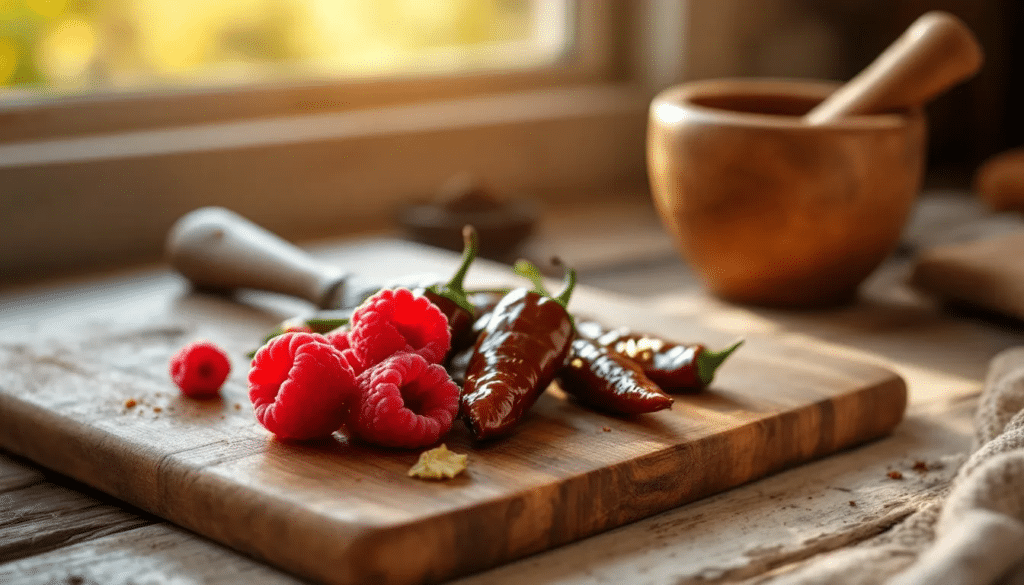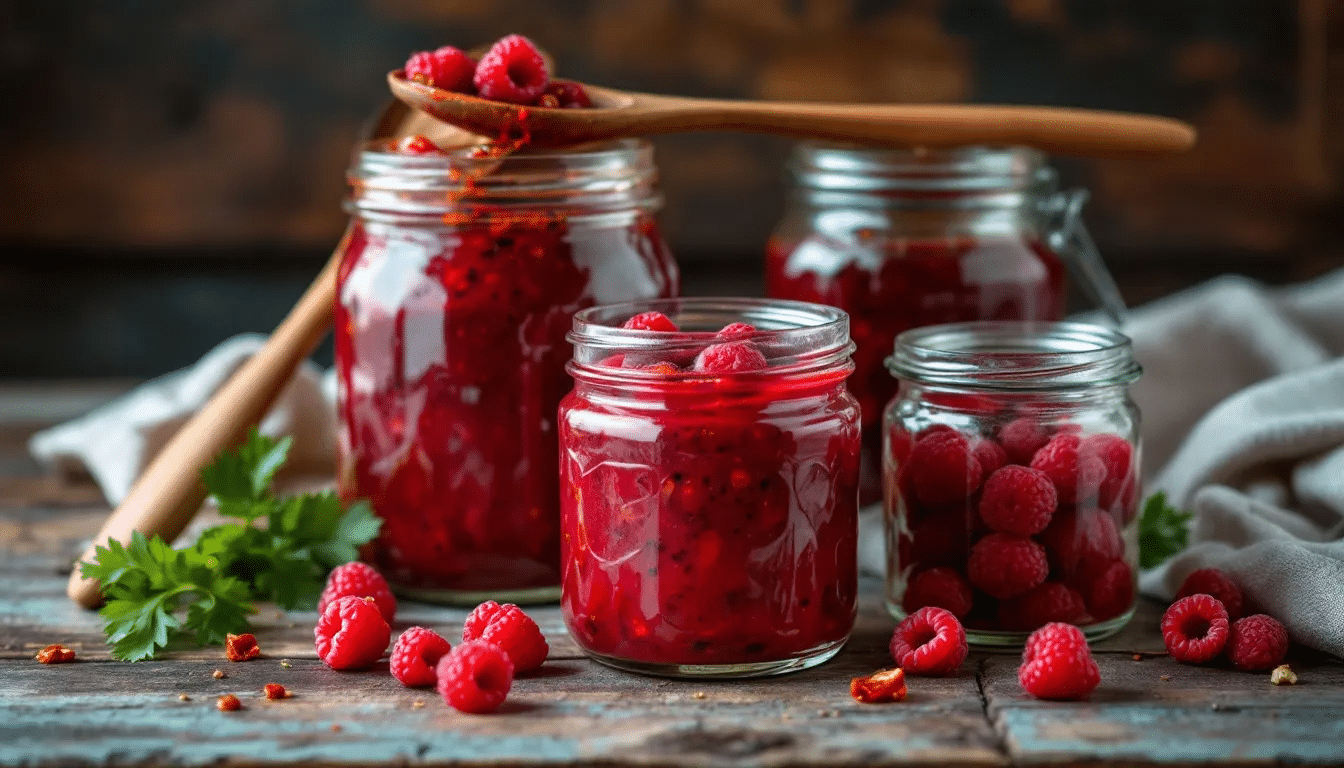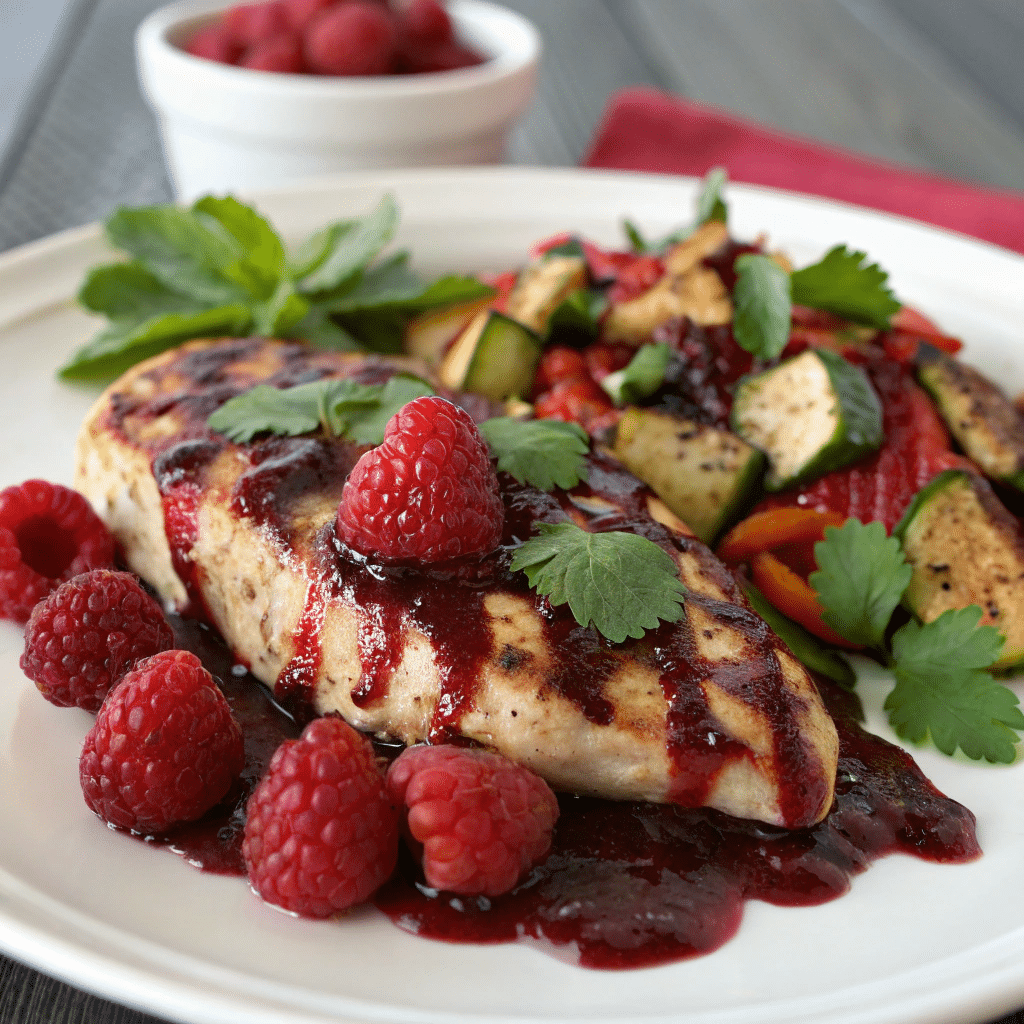Raspberry chipotle sauce is a delightful blend of sweet raspberries, smoky chipotle peppers, and chopped chilies, creating a versatile condiment perfect for grilling, dipping, and more. In this article, you’ll discover how to make this delicious sauce, learn about variations, and get inspired with serving suggestions.
Introduction to Raspberry Chipotle Sauce
Raspberry chipotle sauce is a sweet and spicy condiment made with fresh raspberries, smoky chipotle peppers in adobo sauce, and a hint of apple cider vinegar. This sauce is perfect for those who love a little heat in their dishes but also want to maintain a sweet and tangy flavor profile. With its versatility, raspberry chipotle sauce can be used as a dipping sauce, a basting sauce, or even as a topping for various dishes. Whether you’re glazing grilled meats, adding a kick to your appetizers, or simply looking for a unique condiment, this sauce is sure to impress.
Table of Contents
Key Takeaways
Key ingredients for raspberry chipotle sauce include fresh raspberries, chipotle peppers, chopped chilies, and a mix of spices; substitutions can tailor it to your taste.
Roast raspberries and combine with a flavorful sauce base for a perfect balance; blend for smoothness or strain for chunkiness.
Use the sauce as a glaze, dip, or appetizer spread, and store it in the fridge for up to five days or freeze for six months.
Essential Ingredients and Substitutions

Creating the perfect raspberry chipotle sauce involves a handful of key ingredients that blend harmoniously. The main components include water, fresh raspberries, and sugar, complemented by chipotle peppers, apple cider vinegar, jalapeno peppers, red bell pepper, black pepper, red pepper flakes, garlic, and assorted spices. Each ingredient contributes to the sauce’s distinctive flavor.
Chopped chilies add an extra layer of heat and complexity, balancing the sweetness of the raspberries.
Fresh raspberries form the vibrant and fruity base of the sauce. When out of season, frozen raspberries work just as well, offering the same tartness with minimal flavor difference.
Get creative with substitutions to suit your taste. For a milder sauce, reduce the chipotle peppers or use milder jalapeno peppers. To increase sweetness, try raspberry preserves or jam in place of fresh raspberries. These tweaks can personalize the sauce to your liking.
Choosing the Right Type of Raspberries
When it comes to choosing the right type of raspberries for your raspberry chipotle sauce, you have a few options. Fresh raspberries are the best choice, as they provide the most vibrant flavor and texture. However, frozen raspberries can also be used as a substitute, especially during the off-season. If you’re using frozen raspberries, make sure to thaw and drain them before using to avoid excess water in your sauce. You can also use raspberry preserves or raspberry jam as a substitute, but keep in mind that they may add more sugar to your sauce, which can alter the balance of flavors. Each option has its own benefits, so choose the one that best fits your needs and availability.
How to Make Raspberry Chipotle Sauce

Begin by preheating your oven to 450°F. Spread fresh raspberries on a baking sheet, toss with sugar, and roast for 12-15 minutes. Roasting intensifies the raspberries’ natural sweetness, adding depth to the sauce.
While the raspberries roast, heat oil in a pan and sauté shallots and garlic until soft and fragrant. Add wine, honey, lemon juice, brown sugar, chipotle chiles, chopped chilies, liquid smoke, and salt. Bring to a boil, then reduce to a simmer. This forms the rich and flavorful base of the sauce.
After roasting, combine the raspberries with the simmering sauce and cook for an additional five minutes. This step melds and develops the flavors, resulting in a well-balanced sauce.
Use an immersion blender to puree the sauce until smooth, or strain through a mesh sieve for a chunkier consistency. Your raspberry chipotle sauce is now ready to serve as a dipping sauce, basting sauce, or in any way you like!
Step-by-Step Instructions
To make raspberry chipotle sauce, follow these step-by-step instructions:
In a blender or food processor, combine 1 cup of fresh raspberries, 1/4 cup of chipotle peppers in adobo sauce, 2 tablespoons of apple cider vinegar, and 1 tablespoon of honey.
Blend the mixture until smooth, stopping to scrape down the sides of the blender as needed.
Heat the mixture in a saucepan over medium heat, stirring constantly, until the sauce has thickened and reduced by half, about 15-20 minutes.
Remove the sauce from the heat and let it cool to room temperature.
Strain the sauce through a fine-mesh sieve to remove the seeds and any remaining solids.
This method ensures a smooth, flavorful sauce that’s perfect for a variety of uses. Whether you’re using it as a dipping sauce, a basting sauce, or a topping, this raspberry chipotle sauce is sure to add a delicious sweet and spicy kick to your dishes.
Flavor Variations
Experimenting with different flavors is part of the fun. Incorporate blueberries for a unique twist or use fruits like cranberries or strawberries, each adding its own distinct sweetness.
For those who enjoy extra heat, incorporating chopped chilies can enhance the spiciness and add a unique texture to the sauce.
For a sweeter sauce, increase the sugar content or substitute with honey. Brown sugar, in particular, adds depth compared to white sugar. Adjusting sugar levels helps balance the heat from the chipotle peppers.
Red bell peppers add sweetness and a pop of color. For a smoky flavor, incorporate adobo sauce, which pairs well with the tartness of the raspberries, creating a well-rounded profile.
Serving Suggestions

Use raspberry chipotle sauce as a glaze for grilled meats like pork tenderloin, chicken, and salmon. Its sweet and spicy notes enhance the natural flavors, making it a hit at barbecues and dinner parties.
As a dipping sauce, it pairs well with meatballs or cocktail sausages. The savory and spicy combination makes it perfect for appetizers, adding an extra layer of flavor. The addition of chopped chilies can provide an extra kick, making it even more appealing as a dipping sauce.
Spread the sauce over cream cheese and serve with crackers for an easy appetizer. This simple combination is great for entertaining or a quick snack. It also complements cheeses and cured meats on a charcuterie board.
Pairing Raspberry Chipotle Sauce with Other Dishes
Raspberry chipotle sauce is a versatile condiment that can be paired with a variety of dishes. Here are some ideas:
Use it as a dipping sauce for pretzels or crackers.
Brush it onto pork tenderloin or chicken breasts during the last few minutes of grilling.
Serve it as a topping for cream cheese and crackers for an easy appetizer.
Use it as a basting sauce for grilled meats or vegetables.
Mix it with sour cream or Greek yogurt for a spicy dip.
Use it as a topping for tacos or grilled cheese sandwiches.
Some other dishes that pair well with raspberry chipotle sauce include:
Grilled pork chops with roasted vegetables
Chicken wings with a side of blue cheese dressing
Grilled salmon with a side of quinoa and steamed asparagus
Veggie burgers with a side of sweet potato fries
Remember, the key to pairing raspberry chipotle sauce with other dishes is to balance the heat and sweetness levels. Experiment with different combinations to find your favorite!
Storing Your Sauce

Store your raspberry chipotle sauce in an airtight container and refrigerate for up to five days to maintain its flavor and prevent spoilage.
For longer storage, freeze the sauce in a freezer-safe container, where it can last up to six months. Cool completely before transferring to prevent freezer burn.
Thaw frozen sauce in the refrigerator overnight and reheat in a saucepan to restore consistency and flavor, ensuring it remains delicious and ready to use.
Creative Uses for Leftover Chipotle Peppers
Use leftover spicy chipotle peppers to add a spicy kick to meatballs, enhancing their flavor. This is a great way to utilize remaining peppers and create a delicious new dish.
Another idea is to create basting sauces for grilling or roasting meats. The smoky and spicy flavor of chipotle peppers pairs beautifully with various meats, adding complexity to your dishes.
Maximizing ingredient usage is economical and allows for new culinary creations. Incorporating leftover chipotle peppers into different recipes ensures no waste while experimenting with unique flavors.
Tips for Reducing Spiciness
If the raspberry chipotle sauce is too spicy, tone down the heat by using only one chipotle chile. This allows you to control and gradually adjust the spiciness.
Remove the seeds from chipotle peppers before adding them to the sauce. Seeds contain most of the heat, so this can significantly reduce spiciness. Limit the adobo sauce to one teaspoon for a milder taste.
These adjustments let you enjoy the delicious flavors of raspberry chipotle sauce without overwhelming spiciness. It’s about finding the right balance for your palate.
Nutritional Information
Raspberry chipotle sauce is a low-fat condiment, containing zero grams of saturated fat, monounsaturated fat, and polyunsaturated fat. It’s a healthier option for adding flavor without added calories from fat.
Before:
Each two-tablespoon serving contains:
200 mg of sodium
15 grams of sugars
no protein
no dietary fiber
no vitamins
This information helps you make informed choices when incorporating the sauce into your meals.
After:
When it comes to adding flavor to your meals, raspberry chipotle sauce is a delicious option that packs a unique and tasty punch. Its blend of sweet and spicy flavors makes it a versatile condiment that can be used in various dishes.
However, for those who may not be accustomed to spicier foods, the thought of using chipotle sauce may seem daunting. But fear not, there are ways to enjoy the delicious flavors of raspberry chipotle without being overwhelmed by its spiciness.
One key tip is to limit the amount of adobo sauce used in the recipe. Adobo sauce is what gives chipotle peppers their heat, so by adding just one teaspoon of it into your dish, you can control the level of spiciness while still getting the smoky and savory flavors. Alternatively, you can also opt for a milder version of chipotle sauce or use a mix of raspberry preserves and regular chipotle sauce to achieve a more balanced flavor.
Another trick is to pair the raspberry chipotle sauce with creamy or cooling elements like sour cream, Greek yogurt, or avocado. This combination not only helps to tone down the spiciness but also adds a smooth and rich texture to your dish.
If you’re still hesitant about using raspberry chipotle sauce in your cooking, start small by using it as a marinade for chicken or pork. This allows the flavors to infuse into the meat while also giving you control over how much sauce is used.
Summary
In summary, raspberry chipotle sauce is a versatile and flavorful addition to any kitchen. With its perfect balance of sweet and spicy notes, it can elevate a wide range of dishes, from grilled meats to appetizers. The recipe is simple to follow, and there are plenty of opportunities to customize it to your liking.
We hope you enjoy making and experimenting with this delicious sauce. Whether you’re using it as a glaze, dipping sauce, or spread, raspberry chipotle sauce is sure to impress your family and friends. Happy cooking!
Frequently Asked Questions
Can I use frozen raspberries instead of fresh ones?
Absolutely, frozen raspberries work great in place of fresh ones and still pack that same tart punch! Go ahead and use them without worries.
How long can I store raspberry chipotle sauce in the refrigerator?
You can keep your raspberry chipotle sauce in the fridge for up to five days in an airtight container. After that, it’s best to toss it!
What can I use to reduce the spiciness of the sauce?
To tone down the spiciness, try using fewer chipotle peppers, taking out the seeds, or cutting back on the adobo sauce. It’ll help you enjoy the flavor without the burn!
Can I freeze the raspberry chipotle sauce?
Absolutely, you can freeze raspberry chipotle sauce in a freezer-safe container, and it’ll stay good for up to six months! Just make sure to leave some space for expansion when you freeze it.
What are some creative uses for leftover chipotle peppers?
Leftover chipotle peppers are perfect for spicing up meatballs or making a flavorful basting sauce for your grilled meats. Get creative and give your dishes a smoky kick!
For more recipes

